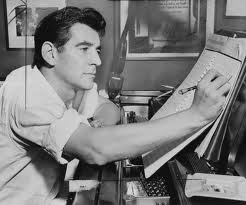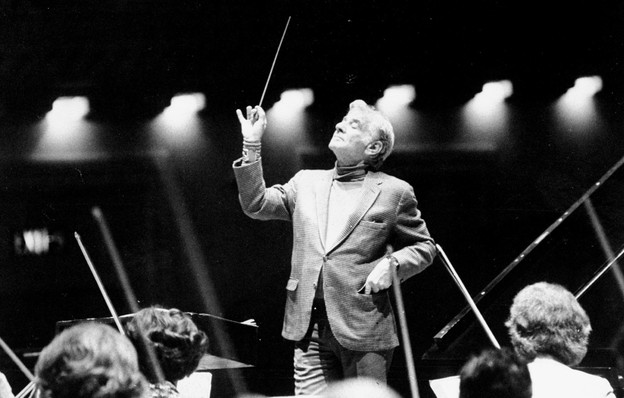One of the longest music director searches in US classical music history is about to come to a surprising and historic conclusion, sources tell View from the Podium reporters, as a major American orchestra prepares to appoint the holographic image of Leonard Bernstein as the holder of the orchestra’s 17th music directorship early next month.
Lawrence, MA native Leonard Bernstein, considered by many the greatest and most charismatic conductor of the 20th century, died in 1990 after a long fight against lung cancer and emphysema. He served as Music Director of the New York Philharmonic from 1957-1969, and had a long and close partnership with the Vienna Philharmonic throughout the 1970’s and 80’s. His discography includes over 400 commercial recordings and 85 DVDs.

Conductor and composer Leonard Bernstein, one of the giants of American music, is to take up his first music directorship since leaving the New York Philharmonic in 1969 and dying in 1990
Appointing Bernstein’s holographic image as the music director of the as-yet undisclosed major American orchestra was the brainchild of the organization’s Executive Director, who was prepared to speak off-the –record with VFTP when reached at his country estate earlier this week.
The “performance” of deceased Tupack which inspired the appointment of Bernstein’s holographic image (adult language)
“My teenage daughter asked me to take her to see the holographic image of Tupac Shakur. I didn’t know what to expect as I prefer East Coast rap to West Coast, but that shit was rad- I couldn’t tell any difference between Tupac’s image and that of the real people on stage. It got me thinking- who says the conductor of a major orchestra actually has to be alive? As long as the audience gets a good show and the players show up and don’t make any obvious mistakes, isn’t everyone happy?”
Archivists and technicians are currently going through huge quantities of filmed footage of Bernstein’s performances from throughout his long career to prepare the computer realizations of his holographic images for his first season, beginning in 2013-14. “Bernstein was filmed extensively from the 1950’s through the 80’s, so we can introduce his holographic image as the youthful and handsome Lenny, and by the end of what we hope will be a long tenure, we can focus on the more mature images generated from his later films with the Vienna Philharmonic,” said one source involved with the preparations.
The announcement has been pushed back to allow time for preparations for Bernstein’s holographic image to take part in a press conference officially announcing his appointment. “Of course he’ll be taking questions,” said a member of the orchestra’s PR team. “Like most conductors, off the podium, Bernstein mostly spoke in platitudes. We’ll just have three or four stock answers ready from him- how he’s always admired the orchestra, how he never wanted another music directorship until he worked with us, how important education and outreach are to him, how he wants to expand our repertoire and focus on new music, how excited he is to work with our administration. All the usual bullshit. Other than that, we’ve got plenty of footage of him sitting around smoking, looking bored. He’ll be as ready as any living conductor ever is for these events.”
For each concert, filmed performances of Bernstein will be used as a template to generate CGI images of an entire performance, allowing the image construction team to refine his podium presence by adjusting his posture, height and reducing perspiration and removing eye bags and skin blemishes. CGI technicians will have to “fill in some gaps” where cameras were not trained on Bernstein in the original concerts. “It’s not a big deal- we hardly have to fill in anything. Directors knew better than to waste much airtime pointing a camera at some bushy-eyebrowed clarinet geek when Leonard ‘effing Bernstein was on TV.” Costs of preparing the projections are estimated at about $200,000 per concert. “That’s probably less than Lorin Maazel was charging at the New York Philharmonic,” said one source with knowledge of the costs, “and we can re-use the images as long as we want.”
Critic Sixtus Beckmesser from the New York Times said the scheme has a lot going for it. “Let’s face it, appointing Bernstein’s holographic image is a brilliant idea. Many of us are put off listening to his New York Philharmonic recordings because of some of the scrappy string playing and very warbly flute vibrato that typified the orchestra’s sound in the 1960’s. No doubt, the performances conducted by Bernstein’s holographic image will sound far better than those he actually participated in as a living human being.”
In the case of the later Vienna Philharmonic concerts, Beckmesser feels that the improvement is a moral one as well as a musical one. “I think we have to acknowledge that many listeners, especially females, are put off watching Lenny’s classic VPO films by the lack of any women players in the orchestra. Now we can hear that the magic qualities of those performances were not dependent on misogyny, and that Lenny’s conducting can get great results even with chicks in the band.”
The musician’s union stipulated that as part of the new MD’s contract, the orchestra will no longer have formal rehearsals. “Let’s face it- our players really consider themselves too good, and too important, to rehearse anyway,” said the orchestra’s executive director. “Rather than waste time rehearsing en masse, players can listen to Bernstein’s recordings in the car on the way to work so they know more or less what to expect.”
The appointment is expected to increase staff efficiency substantially. “Most of my colleagues are green with envy,” admitted the Executive Director. “I’d say that 30% of any senior orchestra administrator’s energy goes into keeping the MD from involving himself or herself in orchestral planning or decision making in any meaningful way. Now, that is an outcome we can take for granted. Bernstein’s hologram will have exactly as much say about what we perform and who we hire as any conductor should have.”
An early note of skepticism was sounded from an influential agent, speaking from an steel-reinforced undisclosed location in the Washington DC suburbs.

America’s most powerful artist manager- “the orchestra had no choice. It was this or “America’s Got Maestros””
“The orchestra was getting desperate because their search was going nowhere. The players had already made it clear they didn’t think there was anyone alive good enough to conduct them, and the management team at the orchestra had burned their bridges with almost every maestro with an international career. It was either appoint Bernstein’s holographic image or ask Simon Cowell to host a nationally televised talent show to find the new conductor and have him record the Christmas number 1 record. Cowell was too expensive.”

Simon Cowell- Approached to take over Music Director search, but too expensive and only interested in “people with real talent- what is conducting anyway? It’s like lip-synching with a stick, only you don’t really have to be that in synch.”
The technique used to put Bernstein back on the podium is described by its inventor as a variation on a classic Victorian illusion, a technique called Pepper’s Ghost, which dates back to the 19th century. Basically, the trick requires two rooms, a main room (in this case, a stage) and an adjacent hidden room. In the main room, there’s an angled piece of glass that reflects an image from the hidden room so that it appears like it’s actually there.
A professor named John Pepper first used the technique in the mid 19thcentury, and it’s now known by his name.
” AV Concepts, the San Diego-based company behind the Tupac performance, used a proprietary Mylar foil, known as Musion Eyeliner, rather than glass. The company said in a press release on Monday that its on-site server “delivered uncompressed media for 3 stacked 1920 x 1080 images, delivering 54,000 lumens of incredibly clear projected imagery.
“It’s, quite literally, a matter of smoke and mirrors. Hell, we don’t even need the smoke. And I think we all realize, Bernstein’s holographic image won’t be the first MD of a major orchestra to get by using smoke and mirrors as his two main musical leadership resources.”
“Let’s face it,” said the orchestra’s principal cellist, “even Bernstein’s holographic image is likely to be a more substantial presence on stage than that of many of his living peers.”

is this serious?? The post date isn’t April 1st…